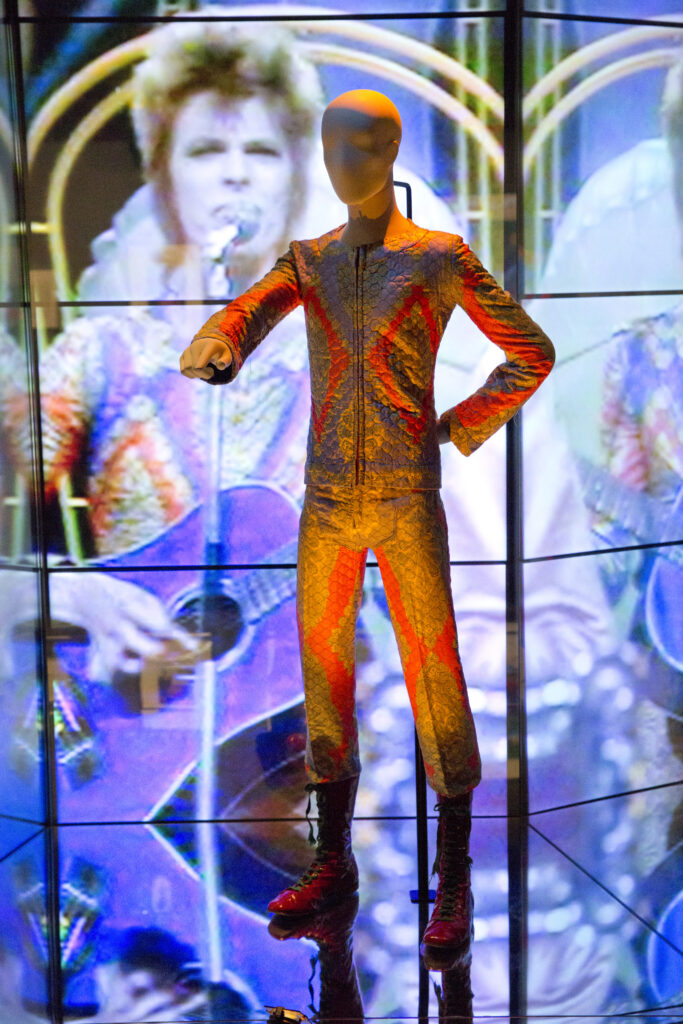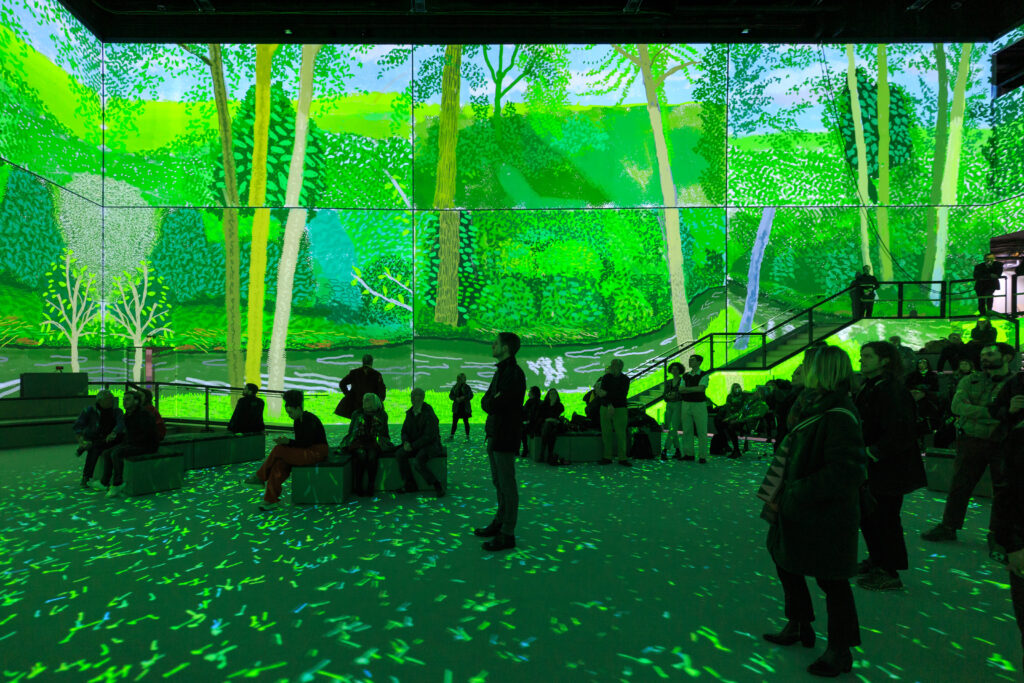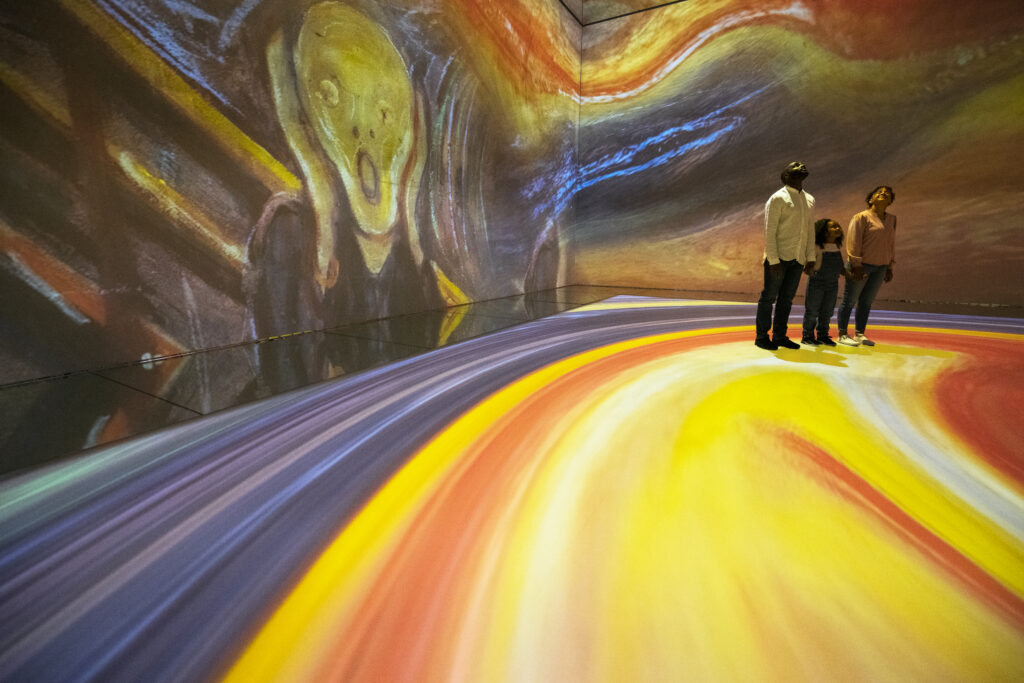Are immersive digital experiences even better than the real thing?
Immersive exhibitions – love them or hate them – seem to be here to stay. Indeed, for anybody visiting central London during the summer, you have the opportunity of sampling at least six, although a full tour of all those would cost you well over £150.
While there are lots of museum displays across the UK that are described as immersive, there is an increasing trend to create vast digital experiences that are often based on the work of artists.
This article looks at four contrasting presentations that have opened in the past 12 months in London – they are all large-scale, immersive and digital.
But why should readers of Museums Journal, with all the problems in the “real” museum and gallery world, bother about this phenomenon?
Well, even if it is low on your list of priorities, along with AI, I would suggest one good reason – knowledge about immersive exhibitions, particularly their income-generating potential, is already seeping into the information networks of local authority councillors and trustees.
If your institution is in a big population centre with large empty column-less buildings, there is a growing chance that your funders may soon be asking why your town or city is missing out on this.
But first, what is the definition of an “immersive” exhibition? There are a few basic characteristics – generally, they feature a 50-60 minute audiovisual spectacle on a single theme, usually famous artists or music, shown on huge screens (up to 10 metres high) in a large space (600-3,000 sq metres) and where the screens are all around you – hence immersive.
There are usually no real objects, and audiences, as opposed to reviewers, are often enthusiastic. If you doubt this, have a look at Tripadvisor’s reviews of sites such as L’Atelier des Lumières in Paris, which has 4.5 stars from more than 2,500 reviews.

Beyond these fundamentals, there is considerable variety. The more sophisticated sites create “promenade” experiences around columns and other features, so you can only see a selection of screens from any one position.
This fragmentation, creating dramatic contrasts, encourages individual exploration and some degree of personal interactivity. Some have a spoken-word commentary but, in my experience, the most powerful are often impressionistic, relying on a musical soundtrack to accentuate pace, rhythm and tension.
The final key characteristic is that these sites can be very profitable if, and it is a big if, they can build a regular annual audience. Think through 300,000 visitors a year at £20 entry or more, then knock off production costs of a couple of million pounds per show, plus rent, marketing and limited staffing, and the potential financial upside is clear. Some sites are reported as approaching close to a million annual visitors.
As a result, most currently lie in the private sector and the biggest barrier seems to be finding suitable city centre sites.
However, the Victoria and Albert Museum (V&A) has demonstrated that immersive experiences can be integrated successfully into object-rich music exhibitions such David Bowie Is in 2013, You Say You Want a Revolution in 2016 and Pink Floyd: Their Mortal Remains in 2017. But there have been few other experiments so far in the UK.
Although immersive exhibitions have a long history, the progenitor of the current trend was the Cathédrale d’Images et Les Baux in Provence, France. Conceived in 1976 by Albert Plécy (1914-1977), a French photographer and image theorist, the concept was extraordinarily simple but hugely effective.
Inside a 3,000 sq metre underground limestone quarry, nearly 100 standard Kodak carousel slide-projectors created a 30-minute show covering every surface of the space, as well as the roof and floor.
Plécy was interested in creating impressionistic rather than didactic presentations, so there was no spoken explanation. Visitors walked around surrounded by a continuous environment of moving images accompanied by complementary music. Although Plécy drew on ideas from expos and other temporary cultural events, he was the first to establish a permanent installation.
In 2012, the site was taken over by Culturespaces, the French commercial operator of museum and heritage sites, and renamed Carrières de Lumières.
With upgraded technology, effective marketing and a focus on big-name “brand” artists as subjects (Van Gogh, Picasso, Klimt, Mondrian, Vermeer, and so on) visitor numbers rocketed towards a million a year.
Culturespaces has successfully cloned the concept in a number of locations, including Paris at L’Atelier des Lumières, where it held the Tintin, The Immersive Adventure, earlier this year.
The company has also developed immersive sites in Bordeaux, Dubai, South Korea and most recently in partnership with IMG in New York at the Hall de Lumières, which opened last year. Culturespaces now has the foundations of the first global immersive exhibition circuit.
The financial success of these has prompted a rash of imitation Van Gogh shows, which in turn has led to the development of new sites in London.
BBC Earth Experience
Visitors experience the natural world across seven continents, including Antarctica, as well as getting a view of our planet taken from space.
- Full adult admission: £32.50
I will start with my visit to the BBC’s Earth Experience, which is on the site of the former Earl’s Court Exhibition Centre.
This has involved the creation of a dismountable new-build structure, meaning that this is the most obvious physical copy of the Carrières de Lumières with multiple screens and a degree of image fragmentation.
But that is where the similarities end, as this is not an impressionistic deep-dive into the mysteries of our planet, but a heavy commercial reuse of the David Attenborough brand. It is, in effect, his television presenting approach blown up to large size.
The film quality is great, the tour commentary of the continents measured and the largely family audience seemingly engaged. However, it all seems rather worthy and curiously politically neutral given global issues.
At one point, the commentary says that there are only a few black rhinos left and they may die out, but it is delivered in a tone of voice one might use to describe a scratch on a car.
Early user reviews suggest serious resistance to the £32.50 price for something that many visitors feel they can watch for free at home, albeit on the small screen.
Overall, it seems a missed opportunity for the BBC to create something genuinely innovative rather than treading a well-worn path.
Hopefully, there will be new programming to give the carefully designed physical space really challenging content to match.
David Hockney at the Lightroom

Visitors to David Hockney: Bigger and Closer (Not Smaller and Further Away) are dwarfed by the art, which is animated and projected onto four-storey-high walls in the Lightroom, a new space in King’s Cross, London.
- Full adult admission: £32.50
In complete physical contrast, the Lightroom at King’s Cross is in the basement of the new Meta offices. The space was designed to be a theatre and it is uncertain when this function will take over.
However, for the moment, it is showing its first immersive presentation – David Hockney: Bigger and Closer (Not Smaller and Further Away), until 1 October, which uses the painter’s images from throughout his career blown up to a huge scale and animated.
The show has been written and produced by Mark Grimmer of 59 Productions in conjunction with Hockney himself. Grimmer has worked with Tate Modern and the V&A as well as a number of theatre and opera companies, while 59 Productions, among many other things, contributed to the legendary 2012 London Olympics opening ceremony.
One of the pleasures of the Hockney immersive is hearing the 85-year-old artist talking with passion and commitment about his working methods and the power of art. The presentation is projected onto the four walls of a rectangular box and is done with the technical quality one expects of 59 Productions work.
Grimmer, having seen many immersive shows of “historic art names”, says he was determined to work with a living artist. Given Hockney’s interest in technology, there is a sense this presentation is a quasi-work of art in itself.
Although more impressionistic than the BBC Earth Experience, it is still a didactic presentation and none the worse for that. I particularly enjoyed the section on Hockney’s opera designs, which was essentially a re-creation of his work in that cultural sector, which is now largely lost.
Overall, more fragmentation and contrast in the imagery would have helped animate the plain box space. I would have also liked to see just one original painting on a central easel, as a conceptual mainspring.
Although there were some children on my visit, the audience was an older art crowd, as one might expect. It will be fascinating to see what Grimmer and his team deliver next.
Frameless

Exhibitions at this permanent multi-sensory venue include works by impressionist painter Claude Monet and modernist painter Edvard Munch
- Full adult admission: £32
- 6 Marble Arch, London
Frameless at Marble Arch, which opened last year, is also in a repurposed building. When planning permission was granted for demolition of the old Odeon cinema, a condition was that it was replaced with a modern facility.
The result, a multiplex of five smallish cinemas, was finished during the Covid lockdown, so unsurprisingly there were no takers.
Then, in stepped Richard Relton, who managed the 2021 tented Van Gogh Alive show in Hyde Park and wanted to create a permanent facility akin to projects such as the L’Atelier des Lumières in Paris, and who has a clear understanding of the format.
The layout of the five cinemas, however, means that, with one as a cafe-shop, there are four standalone sections – titled Colour in Motion, Beyond Reality, Abstraction and The World Around Us. Visitors can enter the spaces in any order and, like the Lightroom, the projections are on the walls.
This division is the core problem, regardless of one’s reaction to the different art themes. Once a section ends, you have to cross over to the next through a dark corridor space, just like the gloomy spaces in a typical multiplex.
In seconds, any emotional engagement is lost, as you try to navigate past other visitors to the next part.
Knowing how tough it is to establish anything in London, hopefully Relton can sort out these problems. Also, it needs a name-change – I found that among non-visitors, no one understands what Frameless means.
Outernet
Offering one of the world’s biggest digital canvasses, Outernet features shows such as The Summer Palace exhibition which blends Renaissance paintings, animation and 3D visuals.
- Free entry
- Tottenham Court Road tube
At the other end of Oxford Street is the Outernet at the exit to Tottenham Court Road tube station, opposite the new @sohoplace theatre. It is one bookend of the reasonably effective restoration and rebuilding of Denmark Street, London’s former “Tin Pan Alley”. And it is part of a much larger underground music facility.
Unlike the other three sites, Outernet’s immersive section is in a new above-ground gold-coloured structure, which is free to enter. Inside are the world’s largest LED screens, covering 23,000 sq ft, which blast images at you – the Summer Palace by Agustin Vidal Saavedra and the Spaces In-Between by Pixel Artworks were on when I visited.
It is difficult to give a description of the effect, but the marketing states: “Outernet is first and foremost a broadcast experience, but on an epic scale. Through the world’s largest LED screens and a 360-degree environment, Outernet will provide brands’ unique storytelling formats that will evolve the future of advertising.” This, of course, explains why it is free.
I was cynical on my first couple of visits but, passing by recently, close to midnight, I was intrigued to see more than 100 people dancing in lines outside. Somehow, in the heart of London, a new public space seemed to be taking off. Perhaps, a truly authentic experiment coming up from the streets? Isn’t that what every local authority is looking for right now?
Life beyond the fourth wall
So, will any of these immersive sites last the test of time? My guess is that, given their investment levels, they will run for a few years, even if the public proves fickle.
To sum up, if you have limited time, money or interest, start with Hockney at the Lightroom. If your bosses are looking to you for strategic guidance, I would recommend a visit to the Carrières de Lumières near Marseilles – it is still the best example of immersive exhibitions.
If you do not want to go to London, visit Manchester and see The Big Picture at the IWM North for free. Bringing people’s experiences of war to life, the immersive has been running since 2002 and proves that these shows can work alongside object-rich displays.
Full disclosure here, I commissioned it in 1997 from the late Steve Simmons of Event Communications as a straight lift from the Plécy’s Cathédrale d’Images.
Exhibition design, like art history, also has its pattern of influences.
Geoff Marsh is a cultural consultant
For more information on this subject, read The Evolution of ‘Immersive’ Exhibitions at the V&A Museum, London, 2008-2021, by Victoria Broackes and Geoff Marsh, which is available here